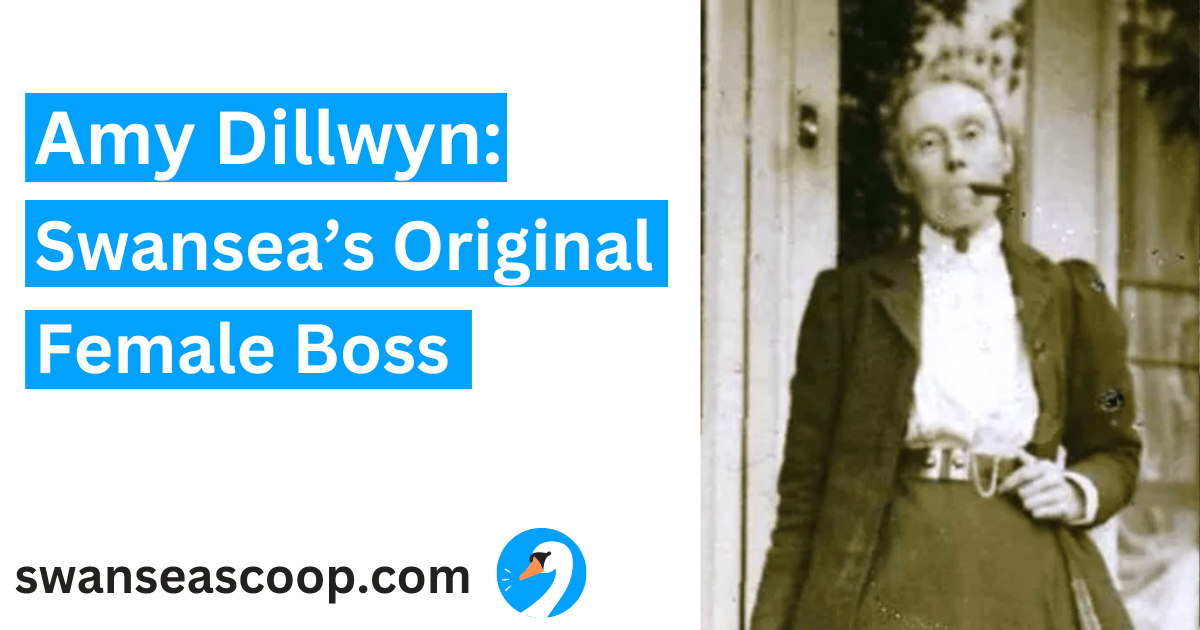
Good morning, Swansea! This week, grab a cuppa and read about one of our city's most revolutionary figures.
When Amy Dillwyn took control of a failing industrial works in the 1890s, she defied all Victorian expectations to become one of Britain's first female industrialists - and changed Swansea's history forever.
Does someone you know deserve a treat? 🍰🥂
Swansea Scoop is giving one lucky person the chance to win Sparkling Afternoon Tea for Two at The Welsh House!

HOW TO ENTER
Simply reply to this e-mail with your name and the word “giveaway” - that’s it!
For two additional entries, head over to Swansea Scoop on Instagram and Facebook.
Entries close THIS FRIDAY March 28th at midnight! The winner will be contacted via DM the next day.
This giveaway is in no way endorsed, sponsored or affiliated with The Welsh House
For full gift voucher terms and conditions, visit thewelsh-house.co.uk/gift-vouchers
An Unlikely Leader
In 1892, Swansea was shocked when one woman made an unprecedented move that would change industrial history.
Amy Dillwyn, a 57 year-old novelist with no formal education or business training, faced a crisis when her father, Lewis Llewelyn Dillwyn – a prominent industrialist and Liberal MP – died suddenly, leaving his Llansamlet zinc spelter works drowning in debt.
The business owed creditors approximately £100,000 – equivalent to millions today – with bankruptcy seeming inevitable. But Amy had other ideas.
She sold everything she owned, moved to cheap lodgings and took over the works herself -an act unheard of in an era when women couldn't even vote, let alone run heavy industrial operations.
The Successful Turnaround
Amy quickly developed a reputation for shrewd management. She studied books on metallurgy to understand the technical aspects of the business and immersed herself in the industry's operations.
She introduced innovative production methods, tightened financial controls, and secured new contracts that competitors had overlooked. To stay competitive, she even traveled as far as Algeria in 1905, embarking on a donkey trek to zinc mines to find raw materials for her works.
Amy would regularly walk the factory floor, discussing technical aspects with workers and examining the processes herself, and often made the four-mile journey to her office in Cambrian Place on foot, or sometimes caught the Mumbles train.
By 1899, the once-bankrupt business had not only cleared its debts but was generating substantial returns. The trading profits had increased from £7,600 to nearly £11,000 by 1902 (equivalent to over £1 million today), making it one of the biggest spelter businesses in the area.
When she eventually sold the business to a German company in 1905, she had completely transformed its fortunes. Her commercial success had saved 300 jobs and demonstrated what a woman could achieve in the male-dominated industrial world.
The Woman Behind the Business
Amy was far from the conventional Victorian lady in both appearance and lifestyle.
She defied many conventions of Victorian society, wearing practical masculine attire and loved to smoke cigars. She became a familiar figure around town, with her suits, plain hat, a small boquet of violets pinned near her collar, and walking stick.
Her personal life was equally unconventional. Amy never married, instead forming a deep bond with Olive Talbot, daughter of another prominent industrial family. Her diaries contain passionate declarations of love for Olive, and by 1872, Amy had begun referring to Olive as her "wife" in her private journals.
Life Beyond Business
Before taking over the zinc works, Amy had established herself as a successful novelist. Between 1880 and 1892, she published six novels that challenged Victorian conventions about gender and class.
Her most famous work, "The Rebecca Rioter" (1880), was revolutionary for its time, sympathetically portraying the Rebecca Riots from the perspective of a young working-class Welsh man.
She was also an early supporter of women's suffrage, saying it was the experience of signing weekly checks for 300 men who could vote when she couldn't that gave her a strong sense of injustice.
Legacy and Recognition
Amy Dillwyn died in Swansea on December 13, 1935, aged 90. Her death received widespread coverage in newspapers across Wales. The Western Mail wrote a lengthy tribute, calling her "one of the most picturesque and outstanding women in the social and industrial life of Wales."
In 2019, she was honoured with a blue plaque at her former home, Tŷ Glyn - now a nursing home - opposite The West Cross Inn. In 2024, the city officially named Amy Dillwyn Park next to Swansea Arena after her, celebrating her extraordinary life and contributions.
You’ll also find a purple plaque dedicated to her on the side of The Green Room, which recognises her as one of Wales' most remarkable women.
Did you know about Amy Dillwyn's remarkable story? Reply to this email and let me know!

Support Swansea Scoop 🦢
If you enjoy the newsletter and get some value from it, would you consider supporting me?
I started this newsletter because I love sharing what makes our city special. If you’d like to chip in to keep it going, you can do so through Buy Me A Coffee - a simple and secure way to send a small one-time or monthly donation.
It's simple - just click, pick an amount, and you're done. No sign-up needed.
Thank you to everyone who has chipped in so far 🙂
Andrew





